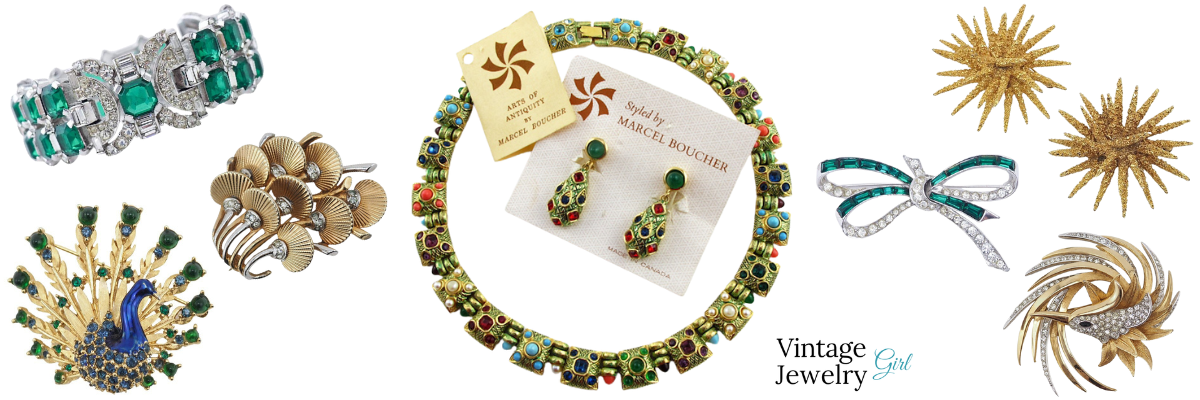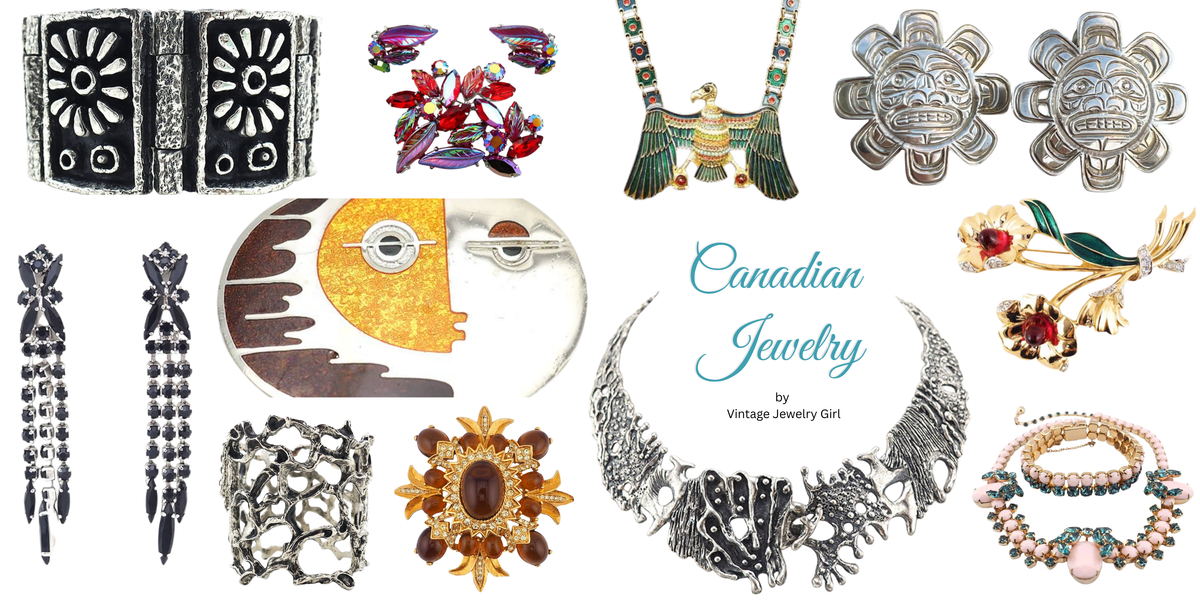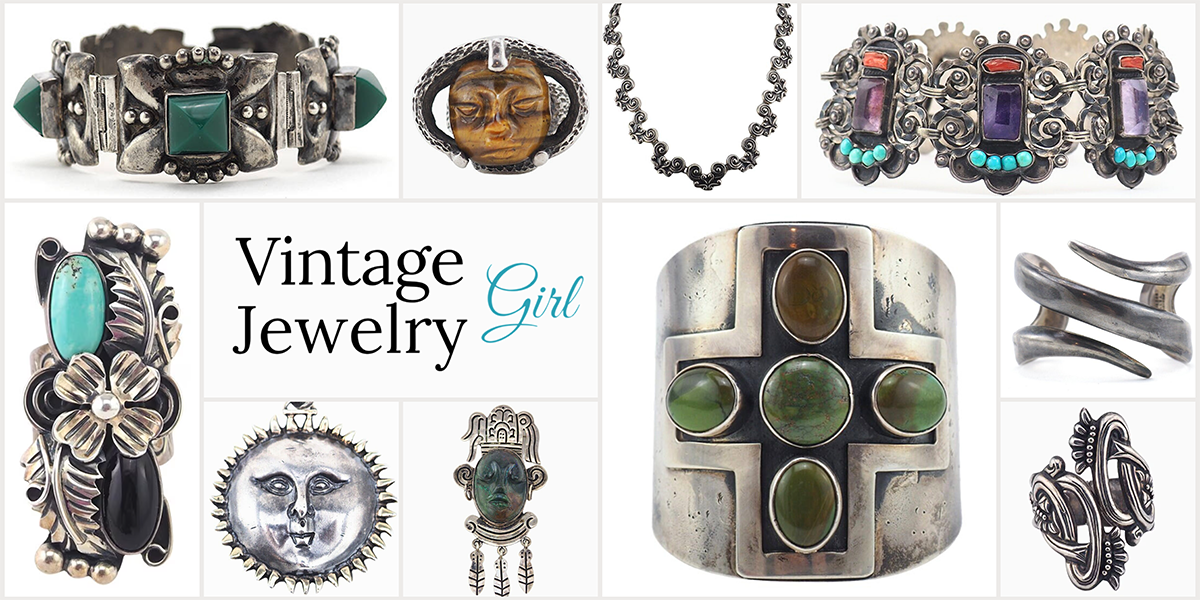Marcel Boucher Vintage Costume Jewelry: A Legacy of Innovative Jewelry Design

Boucher Jewelry History
Shop our selection of Boucher Jewelry
OR
Jump to Boucher Jewelry Marks
*All images and text on this site are subject to Copyright © Vintage Jewelry Girl.
The following information on Boucher jewelry history has been in part, adapted and sourced from an article from the Vintage Fashion & Costume Jewelry Volume 10 No4 from Fall 2000. The original article was written by Nicholas Tollemache who had interviewed Sandra Boucher and discussed her designs and the work of her husband Marcel Boucher.
This article answers these main questions about vintage Boucher (pronounced “boo-shay”) jewelry:
1. How did Sandra join Boucher and what was her role in the company?
Sandra joined Boucher in 1949 after Marcel Boucher invited her for an interview. She initially worked on refining designs and played a crucial role in continuing Marcel's innovative work after his business partner left.
2. What was Marcel Boucher's background and how did he become a prominent jewelry designer?
Marcel Boucher worked as an apprentice jeweler for Cartier and later co-founded his own jewelry business. His innovative designs, particularly his three-dimensional, naturalistic costume jewelry, gained immediate recognition.
3. What were some key challenges faced by Boucher's business, and how did they adapt to them?
Marcel Boucher faced challenges like piracy of designs, a decline in industry standards, and the pressure to compete with low-cost manufacturers. He also navigated changes during World War II and transitioned to fine jewelry before returning to costume jewelry after setbacks.
4. How did Sandra's career evolve after Marcel's death, and how did she manage the business?
After Marcel’s death in 1964, Sandra took over the business. She continued running the company until 1970 and eventually sold the business to Davorn Industries. She then freelanced for other companies and taught jewelry design at the Fashion Institute of Technology.
5. What is the legacy of Marcel Boucher and how did Sandra contribute to it?
Marcel Boucher’s legacy is defined by his innovative designs and attention to detail. Sandra played a key role in continuing his work, both as a designer and later as a teacher and freelancer. She is praised for her fluid, recognizable style and contributions to both fine jewelry and costume jewelry.
6. What marks can be found on Boucher jewelry?
Marcel Boucher Vintage Costume Jewelry:
An Interview With Sandra Boucher
Sandra joined Boucher in 1949 after receiving an unexpected interview invitation from Marcel Boucher, a renowned costume jeweler. At the time, she designed fine jewelry for Harry Winston but sought the creative freedom of costume jewelry. Marcel, needing help after his business partner Arthur Halberstadt’s departure, saw her as the perfect fit. With business booming, he managed both design and sales, making Sandra’s role essential in continuing his innovative work.
Sandra was thrilled when she received Marcel's letter, seeing it as a great opportunity. Encouraged by others, she called him, charmed by his voice. During the interview, Marcel was professional, testing her color sense with stones, and asked her to return with a design. She brought back a flame-shaped brooch, which he liked and immediately put into production after offering her the job.
Born in Paris in 1898, Marcel Boucher was the only son of a widow. During World War I, he served in the French ambulance corps, a period he rarely discussed. He joined Cartier as an apprentice jeweler around 1920, but didn’t speak much about his time there. Although trained as a model maker, not a designer, he never met Louis Cartier or chief designer Charles Jacqueau, and preferred not to dwell on his early career.
Around 1923, Marcel was transferred by Cartier to their New York workshop, but Sandra has no records of his work there. After the 1929 Wall Street Crash, fine jewelry suffered, and Cartier’s business declined. Marcel found work with another jeweler and remained relatively unaffected by the Depression. He also did freelance work, including designing shoe buckles and costume jewelry for Mazer Brothers, which sparked his enthusiasm for the possibilities of costume jewelry.
In 1936, Marcel recognized a shift in jewelry trends and, drawing on his Paris connections, decided to launch a collection of three-dimensional, naturalistic costume jewelry brooches. These designs were revolutionary for their time, marked with his initials "MB" topped by a Phrygian bonnet, a symbol of the French Revolution. By 1937, he co-founded his costume jewelry firm with Halberstadt, and the new collection was a success, earning him immediate recognition. Over the next four years, Marcel created bold, chic, and innovative designs, including fruits, birds, insects, and more, which Sandra described as "couture" jewelry, unlike anything in the Art Deco style.

Image sourced from Julia C. Carroll’s article on Boucher jewelry.
The jewelry was produced in a 10,000-square-foot workshop on the tenth floor of 304 E 23rd St in Manhattan. Marcel's office overlooked the production area, separated by wire mesh for full visibility. After finalizing a design, Marcel worked closely with two skilled German model-makers, ensuring every detail was precise. His mechanical expertise allowed him to create custom tools for complex designs like the "Punchinello" and "night and day" flowers. Once approved, a final model was made, followed by 12 prototypes to calculate production costs and set prices with Halberstadt. After processing, the pieces went through casting, polishing, assembly, and sometimes enameling before being packed for shipment.

"a very gay animated conversation piece by.. MARCEL BOUCHER"
"He's really too precious for words. With moonstone face and pearl-topped staff, colorfully costumed in pastel enamels and rhinestones, he'll excite envy and adoration. At a slight tug of the chain, he'll fling his arms and legs in wild abandon. He's something to talk about-a true conversation piece.... About $10.00. AT ALL LEADING STORES"
During World War II, the U.S. restricted the use of white metal for costume jewelry, so Marcel moved production to Mexico, where he produced sterling jewelry. He spent half the year in Mexico, overseeing the "Parisiana" line, and the other half in New York working on military projects, including model ships for the Navy. After the war, he sold the Mexico operation and returned to New York, where he produced a wide range of designs, including elegant parures inspired by Dior's "New Look." He implemented a detailed control system for orders and began marking pieces with numbers that matched his catalog. By the time Sandra arrived in 1949, the factory had changed little, but she felt cramped in a small space behind the wire mesh. Her first task was touching up artwork for the "Ballet of Jewels" collection. Marcel’s meticulous nature was evident, as he spent hours perfecting designs, even using real ballet shoes as references.
Sandra was kept busy with two collections each year, Spring/Summer and Fall/Winter, totaling around 300 designs. Each year, they created a showcase piece for stores called the "first-nighter," like the "Miss America" tiara. Marcel would initially develop the design concepts, passing them to Sandra to refine or complete. Over time, she began creating her own designs, with Marcel offering feedback like, "Let's do this one, but drop that one." One of her creations from this period was the Hummingbird.
The costume jewelry world was small, and piracy of designs was rampant. Marcel despised this, once suing Coro after they copied his designs. He won, but the legal fees exceeded the damages. To combat piracy, he had exclusive cabochon stones made in non-standard sizes that could not be copied. When he ventured into fine jewelry in the 1950s, his designs were pirated before production even began, leading him to abandon the idea in frustration.
Marcel launched the Marboux line to offer more affordable jewelry, filling the gap left by his premium designs, though it was discontinued when Sandra joined. He also sold to Ciro, which had stores in New York, London, and Germany, adding their name to the pieces for large orders. Marcel expanded internationally, earning royalties from sales in Belleville, Canada, and briefly attempted to enter the French market in 1953-54, though with limited success. The Canadian market was more receptive, with customers traveling to New York to select designs, which were then produced in Canada.
By the 1950s, Marcel’s business employed 60-80 people, and he kept it small, preferring to make jewelry to order, producing as few as 50 pieces for unpopular designs. He was cautious about growth, saying, “One bad year and you are in trouble.”
In the mid-1950s, Marcel grew frustrated with the industry's declining standards. To cut costs, some Boucher designs were produced cheaply in Providence, and the backs of pieces were no longer polished. The rise of high-volume, low-quality manufacturers led to price competition, and buyers, focused on short-term profits, ordered based on sales figures, which stifled innovation and quality.
By 1958, Marcel and Sandra sought a new challenge, and he helped Sandra secure the position of Chief Designer at Tiffany & Co. She managed a small team, working closely with Tiffany’s renowned designer Jean Schlumberger, though they only met briefly. Sandra found fine jewelry too conservative by 1961, so she returned to Boucher, where she and Marcel created the popular enamelled peacock, among other innovative designs like leather, ostrich, and mother-of-pearl pieces. They also designed a series of finely detailed dogs, and Sandra recalls the skunk as the only freelance design produced during this time.

Image Copyright and courtesy of Vintage Jewelry Girl.
In October 1964, Sandra and Marcel married, but shortly after their honeymoon, Marcel was diagnosed with terminal cancer and passed away within six weeks. He entrusted the business to Sandra, knowing she would preserve the jobs and continue the work. Despite the overwhelming challenges, Sandra managed both design and business tasks, though she lacked experience in areas like banking. Some doubted she would last in the industry, but she kept the business going until 1970. She found solace in traveling to remote destinations like Nepal, the Amazon, and Antarctica.
Eventually, meeting payroll became unsustainable, and Sandra sold the business to Irving Ornstein of Davorn Industries, agreeing to design watches and costume jewelry for five years. During this period, she designed watches marked “Marcel Boucher.” After leaving Davorn, Sandra continued her design work, freelancing for Ciner and other companies, and returning to fine jewelry, as she felt mass-produced costume jewelry had deteriorated in quality. The Boucher name and designs were later sold to Stutz Fashion. At some point afterward, D’Orlan acquired the Boucher molds and designs, producing jewelry from them under its own branding. D’Orlan later, would come to be known for their licensed collaboration with Nina Ricci.
Sandra reflects on Marcel’s legacy: his innovative three-dimensional designs and colorful enamels set his work apart. He was both a talented designer and a skilled jeweler who took pride in his work. Sandra’s personal style was fluid and recognizable. Throughout her career, Sandra successfully navigated the world of fine jewelry and costume jewelry, achieving remarkable accomplishments in both areas. She and Marcel always sought the next challenge and never dwelled on the past, which kept their designs ahead of their time.
Below is a list of the different marks you may find on jewelry by Boucher:
- Marboux — 1955 (new, less expensive line)
- Boucher — 1950 to 1955
- MB with Phrygian cap — 1937 to 1949 (and later when space was limited)
- Marcel Boucher — 1938
- Parisina — Sterling, made in Mexico during WWII
- Earrite — 1950
- LeC (Le Couturier) with number — Rare, high-end Canadian line
- Le Couturier — Same as LeC
- Made in Canada, Boucher — Canadian made
- Boucher 3033 — 1950
- Boucher — 1950 to 1955
- "Boucher" with copyright mark — 1955 and onward
- Boucher, Gladiolas — Specific design mark?
- AVON of Belleville — many pieces designed by Boucher
Sources used in this article:
1. Vintage Fashion & Costume Jewelry Volume 10 No4 from Fall 2000. Article written by Nicholas Tollemache
2. Jewelry Marks: Costume Jewelry Collector's International - Boucher Marks


